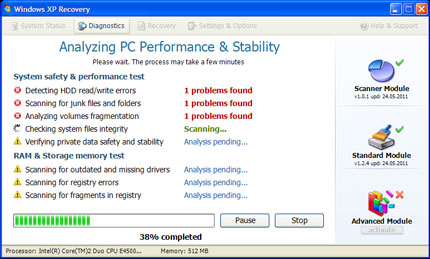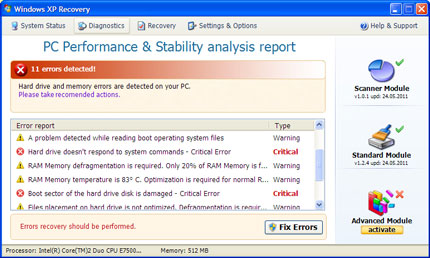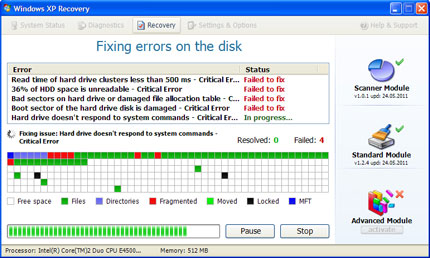TROJ_FAKEAV.SMCJ
Trojan.FakeAV (Symantec); Trojan:Win32/FakeSysdef (Microsoft); Mal/FakeAV-LS (Sophos)
Windows 2000, Windows XP, Windows Server 2003


Threat Type: Trojan
Destructiveness: No
Encrypted: No
In the wild: Yes
OVERVIEW
This Trojan moves .LNK files to the folder it creates and modifies the attributes of the files found in the affected system. This tricks the users into believing that the files have been deleted.
This Trojan arrives on a system as a file dropped by other malware or as a file downloaded unknowingly by users when visiting malicious sites.
It deletes itself after execution.
It displays fake alerts that warn users of infection. It also displays fake scanning results of the affected system. It then asks for users to purchase it once scanning is completed. If users decide to purchase the rogue product, users are directed to a certain website asking for sensitive information, such as credit card numbers.
TECHNICAL DETAILS
Arrival Details
This Trojan arrives on a system as a file dropped by other malware or as a file downloaded unknowingly by users when visiting malicious sites.
Installation
This Trojan drops the following copies of itself into the affected system:
- %System Root%\All Users\Application Data\{random filename}.exe
(Note: %System Root% is the root folder, which is usually C:\. It is also where the operating system is located.)
It creates the following folders:
- %User Temp%\smtmp
- %Start Menu%\Programs\{OS Name} Recovery
(Note: %User Temp% is the current user's Temp folder, which is usually C:\Documents and Settings\{user name}\Local Settings\Temp on Windows 2000, XP, and Server 2003.. %Start Menu% is the current user's Start Menu folder, which is usually C:\Windows\Profiles\{user name}\Start Menu on Windows 98 and ME, C:\WINNT\Profiles\{user name}\Start Menu on Windows NT and C:\Windows\Start Menu or C:\Documents and Settings\{User name}\Start Menu on Windows 2000, XP, and Server 2003.)
Autostart Technique
This Trojan adds the following registry entries to enable its automatic execution at every system startup:
HKEY_CURRENT_USER\Software\Microsoft\
Windows\CurrentVersion\Run
{random file name} = "%System Root%\All Users\Application Data\{random file name}.exe"
Other System Modifications
This Trojan adds the following registry entries:
HKEY_CURRENT_USER\Software\Microsoft\
Windows\CurrentVersion\Policies\
ActiveDesktop
NoChangingWallpaper = "1"
HKEY_CURRENT_USER\Software\Microsoft\
Windows\CurrentVersion\Policies\
Associations
LowRiskFileTypes = "/{hq:/s`s:/ogn:/uyu:/dyd:/c`u:/bnl:/ble:/sdf:/lrh:/iul:/iulm:/fhg:/clq:/kqf:/`wh:/lqf:/lqdf:/lnw:/lq2:/l2t:/v`w:/rbs:"
HKEY_CURRENT_USER\Software\Microsoft\
Windows\CurrentVersion\Policies\
Attachments
SaveZoneInformation = "1"
HKEY_CURRENT_USER\Software\Microsoft\
Windows\CurrentVersion\Policies\
System
DisableTaskMgr = "1"
HKEY_CURRENT_USER\Software\Microsoft\
Windows\CurrentVersion\Policies\
Explorer
NoDesktop = "1"
HKEY_LOCAL_MACHINE\SOFTWARE\Microsoft\
Windows\CurrentVersion\policies\
system
DisableTaskMgr = "1"
It modifies the following registry entries:
HKEY_CURRENT_USER\Software\Microsoft\
Windows\CurrentVersion\Explorer\
Advanced
Hidden = "0"
(Note: The default value data of the said registry entry is 1.)
HKEY_CURRENT_USER\Software\Microsoft\
Windows\CurrentVersion\Explorer\
Advanced
ShowSuperHidden = "0"
(Note: The default value data of the said registry entry is 1.)
HKEY_CURRENT_USER\Software\Microsoft\
Internet Explorer\Download
CheckExeSIgnatures = "no"
(Note: The default value data of the said registry entry is yes.)
Dropping Routine
This Trojan drops the following files:
- %System Root%\All Users\Application Data\{random filename}.exe - also detected as TROJ_FAKEAV.SMCJ
- %Desktop%\{OS Name} Recovery.lnk
- %Start Menu%\Programs\{OS Name} Recovery\{OS Name} Recovery.lnk
- %Start Menu%\Programs\{OS Name} Recovery\Uninstall {OS Name} Recovery.lnk
(Note: %System Root% is the root folder, which is usually C:\. It is also where the operating system is located.. %Desktop% is the current user's desktop, which is usually C:\Windows\Profiles\{user name}\Desktop on Windows 98 and ME, C:\WINNT\Profiles\{user name}\Desktop on Windows NT, and C:\Documents and Settings\{User Name}\Desktop on Windows 2000, XP, and Server 2003.. %Start Menu% is the current user's Start Menu folder, which is usually C:\Windows\Profiles\{user name}\Start Menu on Windows 98 and ME, C:\WINNT\Profiles\{user name}\Start Menu on Windows NT and C:\Windows\Start Menu or C:\Documents and Settings\{User name}\Start Menu on Windows 2000, XP, and Server 2003.)
Other Details
This Trojan deletes itself after execution.
Rogue Antivirus Routine
This Trojan displays fake alerts that warn users of infection. It also displays fake scanning results of the affected system. It then asks for users to purchase it once scanning is completed. If users decide to purchase the rogue product, users are directed to a certain website asking for sensitive information, such as credit card numbers.
NOTES:
It moves .LNK files to the created folder %User Temp%\smtmp. It modifies the attributes of files found in the affected system into Hidden, to trick the users that the files have been deleted.
It may install itself on the infected system as a rogue antivirus using the following names:
- {OS Name} Recovery
- {BLOCKED}ago.org
- {BLOCKED}animal.org
- {BLOCKED}ant.org
- {BLOCKED}asleep.org
SOLUTION
Step 1
For Windows XP and Windows Server 2003 users, before doing any scans, please make sure you disable System Restore to allow full scanning of your computer.
Step 2
Scan your computer with your Trend Micro product and note files detected as TROJ_FAKEAV.SMCJ
Step 3
Restart in Safe Mode
Step 4
Delete this registry value
Important: Editing the Windows Registry incorrectly can lead to irreversible system malfunction. Please do this step only if you know how or you can ask assistance from your system administrator. Else, check this Microsoft article first before modifying your computer's registry.
- In HKEY_CURRENT_USER\Software\Microsoft\Windows\CurrentVersion\Run
- {random file name} = %System Root%\All Users\Application Data\{random file name}.exe
- {random file name} = %System Root%\All Users\Application Data\{random file name}.exe
- In HKEY_CURRENT_USER\Software\Microsoft\Windows\CurrentVersion\Policies\ActiveDesktop
- NoChangingWallpaper = 1
- NoChangingWallpaper = 1
- In HKEY_CURRENT_USER\Software\Microsoft\Windows\CurrentVersion\Policies\Associations
- LowRiskFileTypes = /{hq:/s`s:/ogn:/uyu:/dyd:/c`u:/bnl:/ble:/sdf:/lrh:/iul:/iulm:/fhg:/clq:/kqf:/`wh:/lqf:/lqdf:/lnw:/lq2:/l2t:/v`w:/rbs:
- LowRiskFileTypes = /{hq:/s`s:/ogn:/uyu:/dyd:/c`u:/bnl:/ble:/sdf:/lrh:/iul:/iulm:/fhg:/clq:/kqf:/`wh:/lqf:/lqdf:/lnw:/lq2:/l2t:/v`w:/rbs:
- In HKEY_CURRENT_USER\Software\Microsoft\Windows\CurrentVersion\Policies\Attachments
- SaveZoneInformation = 1
- SaveZoneInformation = 1
- In HKEY_CURRENT_USER\Software\Microsoft\Windows\CurrentVersion\Policies\System
- DisableTaskMgr = 1
- DisableTaskMgr = 1
- In HKEY_CURRENT_USER\Software\Microsoft\Windows\CurrentVersion\Policies\Explorer
- NoDesktop = 1
- NoDesktop = 1
- In HKEY_LOCAL_MACHINE\SOFTWARE\Microsoft\Windows\CurrentVersion\policies\system
- DisableTaskMgr = 1
- DisableTaskMgr = 1
Step 5
Restore this modified registry value
Important: Editing the Windows Registry incorrectly can lead to irreversible system malfunction. Please do this step only if you know how or you can ask assistance from your system administrator. Else, check this Microsoft article first before modifying your computer's registry.
- In HKEY_CURRENT_USER\Software\Microsoft\Windows\CurrentVersion\Explorer\Advanced
- From: Hidden = 0
To: 1
- From: Hidden = 0
- In HKEY_CURRENT_USER\Software\Microsoft\Windows\CurrentVersion\Explorer\Advanced
- From: ShowSuperHidden = 0
To: 1
- From: ShowSuperHidden = 0
- In HKEY_CURRENT_USER\Software\Microsoft\Internet Explorer\Download
- From: CheckExeSIgnatures = no
To: yes
- From: CheckExeSIgnatures = no
Step 6
Search and delete this folder
Step 7
Search and delete these files
Step 8
Scan your computer with your Trend Micro product to delete files detected as TROJ_FAKEAV.SMCJ. If the detected files have already been cleaned, deleted, or quarantined by your Trend Micro product, no further step is required. You may opt to simply delete the quarantined files. Please check this Knowledge Base page for more information.
Did this description help? Tell us how we did.





